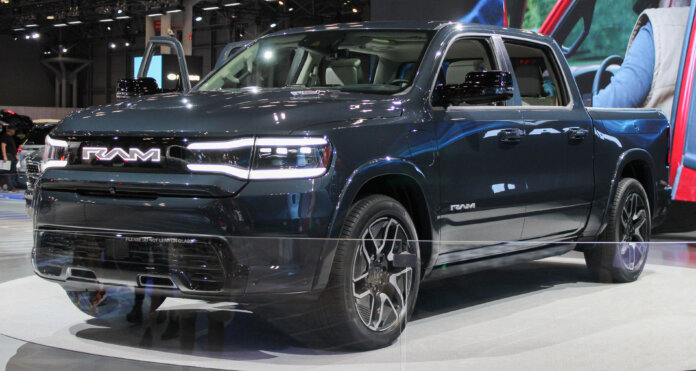Stellantis is investing more than $406 million in three Michigan facilities to support its multi-energy strategy and confirmed that the Sterling Heights Assembly Plant (SHAP) will be the company’s first U.S. plant to build a fully electric vehicle.
The Ram 1500 REV, the company’s first battery electric light-duty pickup truck launching in late 2024, and the new range-extended 2025 Ram 1500 Ramcharger will be built alongside internal combustion engine (ICE) models in Sterling Heights. Additional investments will be made to retool the Warren Truck Assembly Plant (WTAP) for production of a future electrified Jeep Wagoneer, and the Dundee Engine Plant (DEP) for battery tray production and beam machining for the STLA Frame and STLA Large batteries.
“Sterling Heights Assembly has performed an incredible transformation in record time, and I want to thank our colleagues for this great achievement,” says Stellantis CEO Carlos Tavares. “Gearing up to build our first-ever Ram electric truck and the range-extended version in Michigan is a meaningful moment of pride for our teams. With these investments supporting both Jeep and Ram, we’re adding innovations to our Michigan manufacturing footprint to support a multi-energy approach that is laser-focused on customer demand.”
With an investment of $235.5 million, SHAP will produce the company’s first battery electric 2025 Ram 1500 REV light-duty truck. The Ram 1500 REV was unveiled at the 2023 New York Auto Show and will launch in late 2024. The plant will also build the new range-extended 2025 Ram 1500 Ramcharger.
As part of SHAP’s multi-energy industrialization strategy, the teams completed the battery electric vehicle (BEV)-specific installations during two planned down weeks, finishing the work ahead of schedule. Stellantis partnered with equipment suppliers and contractors to plan and execute the installation of a new conveyor system, new automation for BEV-specific processes, and the retooling and rearrangement of workstations in general assembly to produce internal combustion engine (ICE), BEV and range-extended models on the same assembly line.
The Ram 1500 REV is built on the new STLA Frame architecture, designed for full-size EVs featuring a body-on-frame design, with a new high-strength steel frame comprised of advanced materials to be lightweight, yet stiff and durable. The STLA Frame is wider in the middle to efficiently incorporate the battery pack while still utilizing protection afforded by the frame rails. The REV will reach up to 500 miles of range with the optional 229-kWh battery pack and up to 350 miles with the 168-kWh battery pack.
The 2025 Ram 1500 Ramcharger offers 663 horsepower, 615 lb.-ft of torque, four-second 0-60 mph, 14,000 lbs. of towing and zero need for a public charger. It features a 92-kWh battery pack, paired with an on-board 130-kW generator, sending power to 250-kW front and 238-kW rear electric drive modules (EDMs). Vehicle-to-vehicle and vehicle-to-home bi-directional charging affords the Ram 1500 Ramcharger the flexibility to charge another Stellantis battery electric vehicle or provide power back to the grid.
Approximately $97.6 million will be invested at the WTAP for production of a future electrified Jeep Wagoneer, one of four Jeep EVs that will be launched globally by the brand before the end of 2025. Electrified models will be built on the same line as ICE versions of the Jeep Wagoneer and Wagoneer L, as well as the Jeep Grand Wagoneer and Grand Wagoneer L.
With an investment of more than $73 million, DEP will be retooled to assemble, weld and test battery trays for the STLA Frame architecture and to machine the front and rear beams for the STLA Large architecture. Production will begin in 2024 and 2026, respectively.
The new components will be built alongside the GME-T4 EVO, launching later in 2024, and the new 1.6-liter, I-4 turbocharged engine with direct fuel injection and flexibility for hybrid-electric vehicle (HEV) applications that will launch in 2025.
Stellantis is investing more than 50 billion euros over the decade in electrification to deliver on the targets of reaching a 100% passenger car BEV sales mix in Europe and 50% passenger car and light-duty truck BEV sales mix in the United States by 2030. To achieve these sales targets, the company is securing about 400 GWh of battery capacity, including support from battery manufacturing plants in North America and Europe. Stellantis is on track to become a carbon net zero corporation by 2038.






I insist on driving the truck for advertising purposes, but only if Stellantis covers the full cost of the vehicle. I frequently travel to the Upper Peninsula and Virginia, making the truck a great opportunity for exposure. I am open to having the truck wrapped in logos and other advertising materials. It’s evident that there is reluctance towards an electric truck in Detroit, but I am confident that I can help change perceptions.